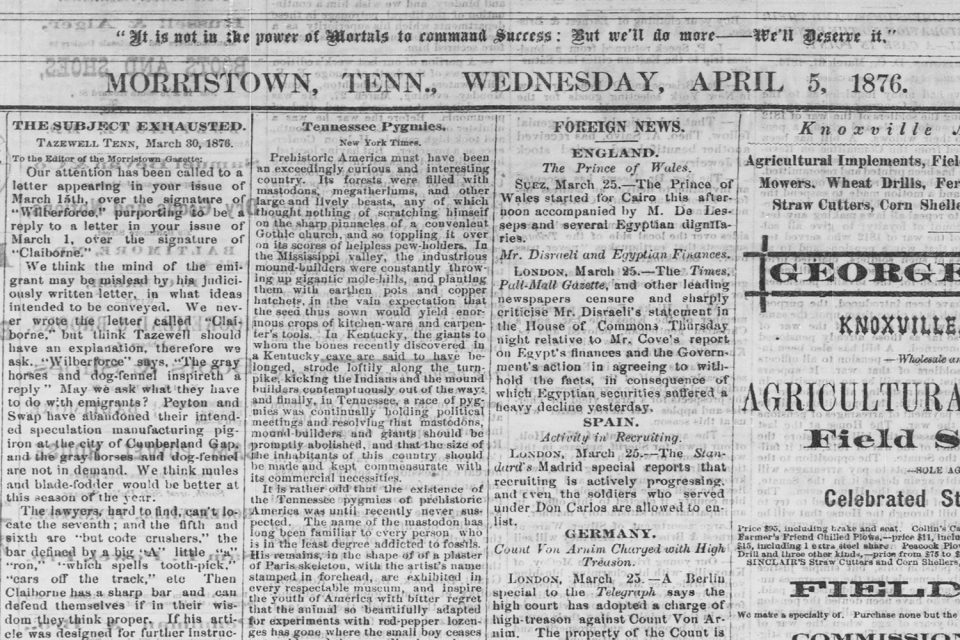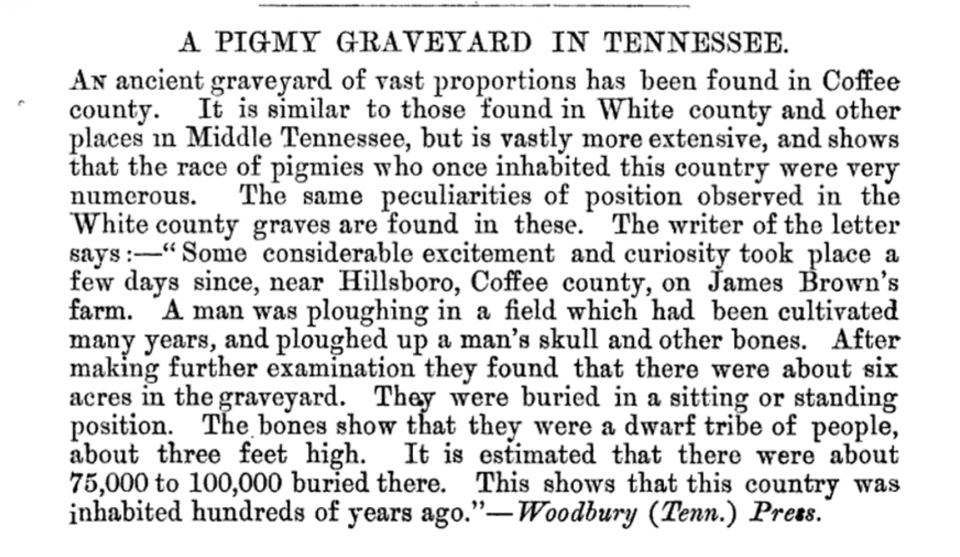Before Bigfoot, before UFOs, America was caught in the grips of a craze that originated in Tennessee: the legend of the Tennessee pygmies
In the early 1800s, a rash of news stories began appearing in Nashville and middle Tennessee newspapers regarding the discovery on middle Tennessee farms of pygmy graves. Through the process of plowing, or by fortune of erosion, farmers and landowners had discovered small graves — rustic rectangular stone boxes or sarcophagi, containing normal size adult skulls, but bones that seemed to indicate that the deceased were not of a normal stature. The boxes were small, approximately two feet long, 14 inches wide, and 16 inches deep.
The earliest known published account of these small stone box burials was in the Nashville Whig newspaper in July 1820, which announced the discoveries on the farm of “Turner Lane, Esq., five miles south east of Sparta [TN], on the waters of the Caney Fork of Cumberland, and on other farms adjacent . . .”
As you can see in the newspaper below, there were still reports being published 50 years later.

Published accounts stirred 19th-century imaginations, and the stories spread to other publications around the US, creating the legend of the Tennessee pygmies. Cherokee folklore seemed to confirm the existence of pygmies, with their belief in a race of little people. Curious experts came to Nashville to investigate grave sites, examine bones, and offer explanations. Farmers began probing their properties with metal rods, stabbing the Earth in search of hard stone lids.
‘Cherokee Little People Were Real’ (Amazon)
This book by Mary A. Joyce highlights testimonies of men who discovered ancient little tunnels, small skeletons and even a child-size skull with all its wisdom teeth when they were working on early construction projects at Western Carolina University in Cullowhee, North Carolina. (Click here to learn more)

Keep in mind, in the 1820s and 30s, even a medical doctor’s understanding of anatomy was lacking compared to our modern knowledge. Some experts confidently declared that these were simply compact boxes containing bundles of normal-sized bones, or perhaps the bones of children, from ancient Native Americans. One expert noted that some western tribes of Native Americans place their deceased on scaffolds for something like a so-called “sky burial,” and may have later given the bones a “second burial” in the stone boxes below the soil. Others weren’t so sure, feeding the pygmy craze.
Once popular legends take hold, they last a long time. The pygmy stories were still being investigated 50 years later, well after the Civil War.
Stature of ancient Native Americans
Ancient human remains excavated at Russell Cave in Alabama, not far from the Tennessee state line, indicate that adults were short and muscular, but at 5-feet-tall, they were still much taller than the 3-foot height claimed for the pygmy graves.
Where did all the bones go?
If there were truly thousands of burials on acres and acres of farmland across middle Tennessee, where did all those bones go? Sure, a few bones may be in museum collections somewhere, but what about the rest?
Unique comb graves — a connection?
Now a curious side story.
In a dramatic and historic hilltop cemetery overlooking the town of Sparta, in White County, Tennessee, there’s a unique style of grave known as a comb grave, or a tent grave. These consist of two long sandstone slabs, propped into a pitched A-style “tent” over the grave, capped on the ends with triangular stones.
According to archaeologist Kevin E. Smith, this style of grave is most often found along the western edge of the Cumberland Plateau of Tennessee in White County and surrounding counties — coincidentally, the same region where the pygmy grave boxes were discovered. Smith speculates whether the appearance of comb graves in the early 1820s might somehow be connected to the integration of the stories of the stone box pygmy graves into Appalachian culture.
Thanks for reading!
Be sure to visit me on Facebook, YouTube, Pinterest, or on my website at keithdotson.com.
~ Keith
Sources:
Smith, Kevin E., Tennessee’s Ancient Pygmy Graveyards: The “Wonder of the Western Country,” 2013
Forbes.com: 10 Boneheaded Interpretations Of Ancient Skeletons
Journal of the Royal Anthropological Institute of Great Britain and Ireland, Volume 6, 1877, Page 100
Note: This blog post contains Amazon Affiliate links. I may earn income from qualifying purchases.
